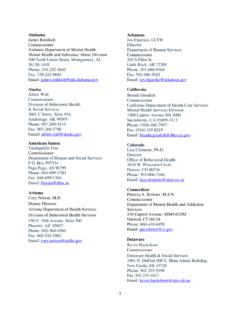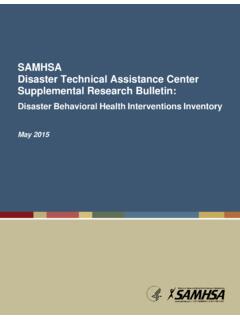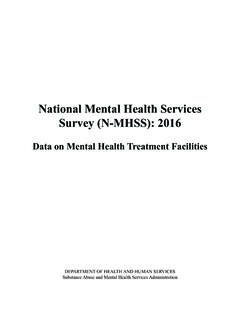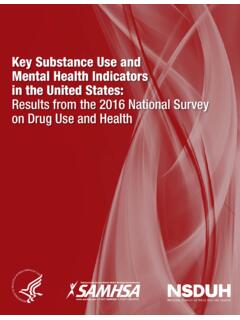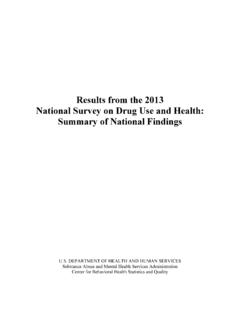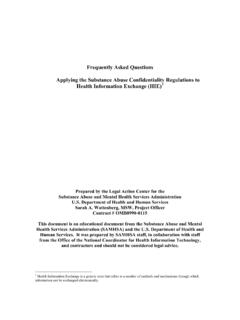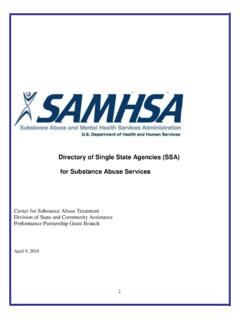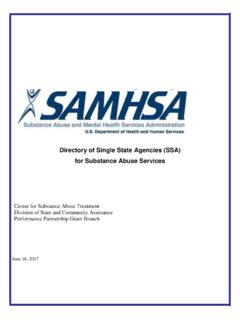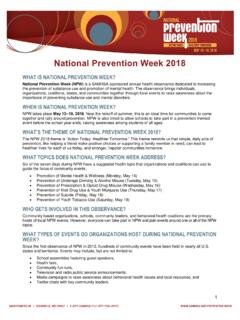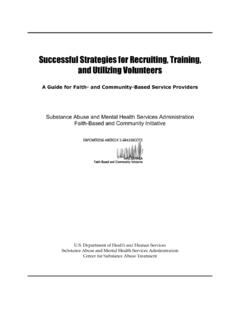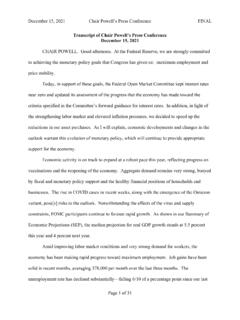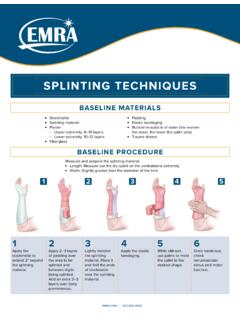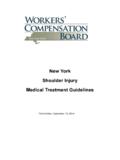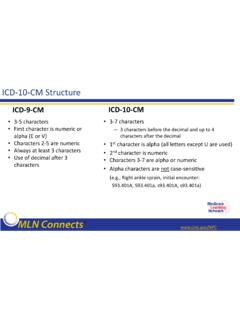Transcription of Greater Impact: How Disasters Affect People of Low ...
1 SAMHSAD isaster Technical Assistance Center Supplemental Research Bulletin Greater Impact: How Disasters Affect People of Low Socioeconomic StatusJuly 2017 CONTENTSINTRODUCTION3 BEFORE THE DISASTER4 Perception of Disaster Risk4 Disaster Preparedness4 Responses to Warning Communication5 DISASTER IMPACT6 Housing and Homelessness7 Residences in Areas at High Risk of Disaster Effects7 More Serious Injuries and Physical Effects8 Financial Effects9 AFTER THE DISASTER9 Difficulty With Obtaining and Receiving Aid9 Lack of Access to Housing10 Stress Associated With Lack of Resources10 Greater Prevalence of Distress and Depression10 Posttraumatic Stress11 Physical Health and Health Problems12 CONCLUSIONS12 Summary of Research12 Policy Implications and Recommendations13 Commitment to Improving Outcomes for People of Low SES in Disasters13 Poverty Mitigation and Reduction13 Safer Housing for People of Low SES14 Response and Recovery Efforts Targeted to Lower Income People14 Response
2 Attuned to Specific Communities, Including People of Low SES14 Evacuation Support for People of Low SES14 Increased Access to Loans, Financial Incentives, and Other Post-disaster Aid15 REFERENCES16 SAMHSA is not responsible for the information provided by any of the webpages, materials, or organizations referenced in this communication. Although the Supplemental Research Bulletin includes valuable information and links, SAMHSA does not necessarily endorse any specific products or services provided by public or private organizations unless expressly stated. In addition, SAMHSA does not necessarily endorse the views expressed by such sites or organizations nor does SAMHSA warrant the validity of any information or its fitness for any particular purpose.| Page 3 INTRODUCTIONThis issue of the Supplemental Research Bulletin focuses on how People in poverty, with low incomes, and of low socioeconomic status (SES) experience Disasters .
3 We explore the differences in risk perception and disaster preparedness, response, and recovery. Although it provides some information on international disaster events, this issue is primarily focused on Disasters that have affected communities within the United behavioral health professionals can use this issue of the Supplemental Research Bulletin to inform their disaster behavioral health planning for low SES populations. The issue helps to clarify the ways in which People of low SES may be at Greater risk than other groups in Disasters , as well as barriers to disaster preparedness and other adverse situations or experiences they may face during the phases of disaster impact, response, and recovery. The issue also includes suggestions for policies to support better outcomes for People of low SES in and after selecting research to review for this Bulletin, we took a broad approach to the topics of wealth and poverty, income, and SES.
4 SAMHSA (2014) defines SES in the United States as related to many factors, including occupational prestige and education, yet .. primarily associated with income level. Because SES encompasses occupation and education as well as income, we use it as a general term in this issue. However, because studies cited in this issue look at multiple factors (for example, income level, poverty, and years of education), we also indicate the exact ways related to SES that researchers identify groups of People affected by this issue, we also use the term vulnerability broadly, to refer to Greater risk of negative experiences, effects, and reactions before, during, and after a disaster. For example, vulnerability for People of low SES may refer to Greater likelihood of living in fragile housing, having difficulty accessing resources after a disaster, and experiencing trauma during and after a disaster.
5 It also may refer to lower likelihood of receiving warnings of Disasters , having the ability to evacuate in response to disaster warnings, and being able to access post-disaster aid. We use vulnerability as a measure of risk or likelihood not of actual negative experiences, effects, and the Bulletin includes insights from comprehensive literature reviews, it is not itself a comprehensive review of the literature. It discusses several review studies, as well as studies that have examined the role that SES has played in several Disasters but it is not the Bulletin, we focus on low SES individuals and communities in particular on studies that look at SES as a dimension of disaster vulnerability and on elements of studies that relate to SES. However, much disaster research, especially recent research, focuses on the intersection and overlapping of more than one type of vulnerability. People who are affected by Disasters and are vulnerable along one dimension often are vulnerable along others as well (for example, age, gender, disability status, level of disaster exposure).
6 In general, People with less power along a variety of dimensions tend to be more vulnerable and may fare more poorly in and after Disasters . In this Bulletin, we use SES as a way to focus on potential disaster vulnerability, but it is by no means the full picture of disaster vulnerability in the real world, where People experience Disasters in distinct ways depending on various aspects of their position in society.| Page 4 BEFORE THE DISASTERB eing of low SES, in the United States and around the world, may Affect how People understand disaster risk, prepare for Disasters , and respond to warnings and evacuation orders. Research suggests that People of differing socioeconomic statuses may prepare for a disaster of Disaster RiskIn a review of research on Disasters as experienced by People in poverty, Fothergill and Peek (2004) report mixed findings related to perception of disaster risk.
7 They cite some studies (Flynn, Slovic, & Mertz, 1994; Pilisuk, Parks, & Hawkes, 1987; Palm & Carroll, 1998) that found that People who were poorer and with lower incomes perceived more risk and felt more concern regarding both natural and technological Disasters . However, they note, other research (Vaughan, 1995; Greene, Perry, & Lindell, 1981) has found People of lower SES and working class People whose jobs involve exposure to risk those with fewer resources, presumably, than those of higher SES and People of middle or other classes with Greater access to resources to be less cognizant of the risks associated with their work. Still other research they mention found no effect of education or income on risk perception (White, 1974). Given the range of findings in this area, Fothergill and Peek conclude that a characteristic such as socioeconomic status should be considered as a possible contributor to, and predictor of, how risks are perceived and interpreted (Vaughan, 1995) but Fothergill and Peek do not predict what the relationship of SES to risk perception will be in most situations (Fothergill & Peek, 2004).
8 Disaster PreparednessSome research has found Americans of low SES to be less prepared than other Americans for Disasters . To provide appropriate context for this finding, it is important to note that Americans in general are not well-prepared for Disasters . The National Center for Disaster Preparedness at Columbia University conducted a national survey in which nearly two-thirds of respondent households (65 percent) reported having no disaster plans or having plans that are not adequate (Sury et al., 2016). And according to national survey data from the Federal Emergency Management Agency (FEMA), less than half of Americans are familiar with local hazards, fewer than 40 percent have created a household emergency plan and discussed it with household members, and only about half (52 percent) reported having disaster supplies at home (FEMA, 2014).Fothergill and Peek report on research that has found People in poverty, with low incomes, and with less education to be less prepared for Disasters (Turner, Nigg, & Paz, 1986; Vaughan, 1995; as cited in Fothergill and Peek, 2004).
9 They point out that this finding may relate to the fact that some preparedness actions are costly, and possibly too costly for People in poverty to afford (for example, purchasing earthquake or flood insurance or strengthening a home for Greater earthquake resilience) (Palm & Carroll, 1998; Fothergill, 2004; as cited in Fothergill and Peek, 2004). In a paper about the effects of Hurricane Katrina on New Orleans, Louisiana residents Masozera, Bailey, and Kerchner (2007) report that districts of the city with high percentages of People in poverty also had low percentages of People with flood the other hand, Fothergill and Peek also relate that researchers investigating preparedness behavior prior to Hurricane Andrew (which took place in August 1992) found no association between | Page 5income levels and timing of preparedness activities, such as having non-electric sources of lighting on hand (for example, candles, a flashlight, a gas-powered lantern), buying or preparing water reserves, buying canned or nonperishable food, and bringing loose objects indoors.
10 The time between beginning preparation and the onset of the hurricane did not vary significantly by income (Gladwin & Peacock, 1997, as cited in Fothergill & Peek, 2004).In line with the idea that preparedness may be too costly for People of low SES, a report from the World Bank and the Global Facility for Disaster Reduction and Recovery (GFDRR) on the impacts of natural Disasters around the world notes that poor People , with fewer resources, tend to invest less in preventing and mitigating the adverse effects of natural hazards and environmental changes (Hallegatte, Vogt-Schilb, Bangalore, & Rozenberg, 2017).One team of researchers looked specifically at preparedness in 1,304 adults ages 50 and older. They found that those in their sample with lower levels of income were significantly less prepared for natural Disasters (Al-rousan, Rubenstein, & Wallace, 2014). This suggests that, as noted in the introduction to this Bulletin, more than one type of vulnerability in this case, older age and lower income may interact to shape how People prepare for, and perhaps eventually experience, Disasters .
